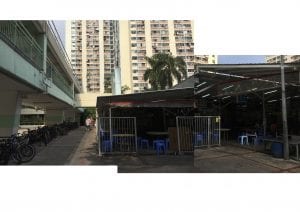We are glad to have Vivien Chan as our contributor this week. Vivien is a design historian based in London. She is currently a PhD candidate on the Cultures of Occupation in Twentieth Century Asia Project at University of Nottingham, and holds an MA in History of Design from the Victoria & Albert Museum/ Royal College of Art. She is also an Ambassador for the Design History Society, and continues her practice as an illustrator/animator/filmmaker.

My research topic is consumer cultures in Hong Kong New Town public housing estates, 1950s – 1980s, and my PhD is part of the Cultures of Occupation in Twentieth Century Asia Project (COTCA). Responding to ‘spaces of occupation’, I wanted to explore the public spaces in Hong Kong that encapsulate the mundane and ordinary aspects of life in this period. The 1950s – 1980s in Hong Kong is a time of transformation, known for its miraculous regeneration after the war through the success of its global manufacturing industry, and reconstructing the shape of the urban landscape to accommodate the increasing needs in the city. In other words, Hong Kong was creating and filled with stuff to be bought and sold, but this was mostly for the export market – so then, what was the consumption practices of those living and working in the city? Rather than the malls that dominate the landscape now, local, everyday consumption took place much closer to home. Consumption, in the form of buying newspapers and sweets, meeting friends for tea, picking groceries for dinner, renting mah jong tables, choosing a new pet goldfish from a hawker’s bucket, or celebrating with a family meal, was largely conducted in the neighbourhood, on your journey between home and work. Shops, markets and hawker stalls were intrinsic modes in the community networks of support, and such spaces of consumption would increasingly be designed into later versions of public housing.
Researching this kind of space reveals a different side to the everyday life in Hong Kong. Neither the ‘dangerous’ fictional stories depicted in movies, nor the privileged journal entries of expatriates and elites, exploring the mundane routines and spaces during a period of great change – in values, way of life, moving through the city, in self-identifying – puts the everyday tactics for surviving and thriving in these conditions at centre stage. A huge community of people made the renewed industrialisation and urbanisation physically happen, but yet their role is little found in the history of the city. In the present day, where the nuances in the experience of history are increasingly eliminated or simplified, it is all the more urgent to locate history in the personal and subjective experiences of the city, and re-interpret the histories that have been written. The necessary and continuous negotiation of identity, culture, memory and heritage in the city can be further diversified through these new perspectives on Hong Kong history.
I became interested in this topic during my research street food stalls for my Master’s thesis, ‘Assembling the Dai Pai Dong: Living and Occupying the Street in Hong Kong, 1950s – present’. While I was in Hong Kong conducting research, I discovered that dai pai dong existed in several different structural forms – one of these forms was the dong gu ting, semi-structured stalls that are mostly found at the outskirts of Hong Kong’s urban centres as part of the facilities at public housing estates. Central (socially and architecturally) to the everyday life of working-class people, then isolated in the New Towns, dong gu ting highlighted the dynamic between the regularity of the formalised prefabricated public housing estate and the seemingly chaotic ways that the community used it. No longer simply for food, or a space confined to men, the dong gu ting was, and still is, an extended dining room for familial connection and remembering. Dai pai dong served as an example of how people changed and manipulated the urban landscape, not explicitly as acts of political resistance, but as everyday negotiations of space. With the PhD project on consumer culture, I hope to extend this further into other spatial forms of consumption.

Such ephemeral subjects can be difficult to trace in traditional archives. Although with this topic I can access documentation, architectural plans and photographs related to public housing estates and neighbourhoods, an interdisciplinary approach will be necessary to fill in the missing links. In my work on dai pai dong, I relied on oral histories conducted by the Hong Kong Heritage Project and Hong Kong Memory to inform the lived experience of the street. I also used my background in design, as an illustrator/animator/filmmaker, to visualise the space, by using photography to document my ethnographic research in the city. I hope to develop these methodologies in my PhD project to give further spatial depth to the research. Objects are also a really valuable, underused resource in research of Hong Kong. Drawing from my work researching objects at the V&A, using the collections in Hong Kong’s museums could provide the tactile, material elements to the research, where in many cases objects in everyday consumption spaces may no longer exist in their original environments.
An inter-disciplinary approach to history means that I can access subjects that have been overlooked by ‘official’ forms of documentation. As a design historian, I’m looking at things and histories that have always been present, but disregarded – the stories told and object kept by ordinary people (rather than elites) are just as legitimate narratives of life in Hong Kong as those kept in archives, and fundamental to contextualising the socio-political climate of the time. By flipping the weight from macro, and largely colonial, narratives to the microhistories, directly from the voices of those experiencing the city, and the material construction of the city itself, we can tell an alternative history of Hong Kong. Design history has the potential to rewrite the power-hierarchy found in the current historiography, and shape the discourse of what ‘design’ and ‘history’ mean in the city.